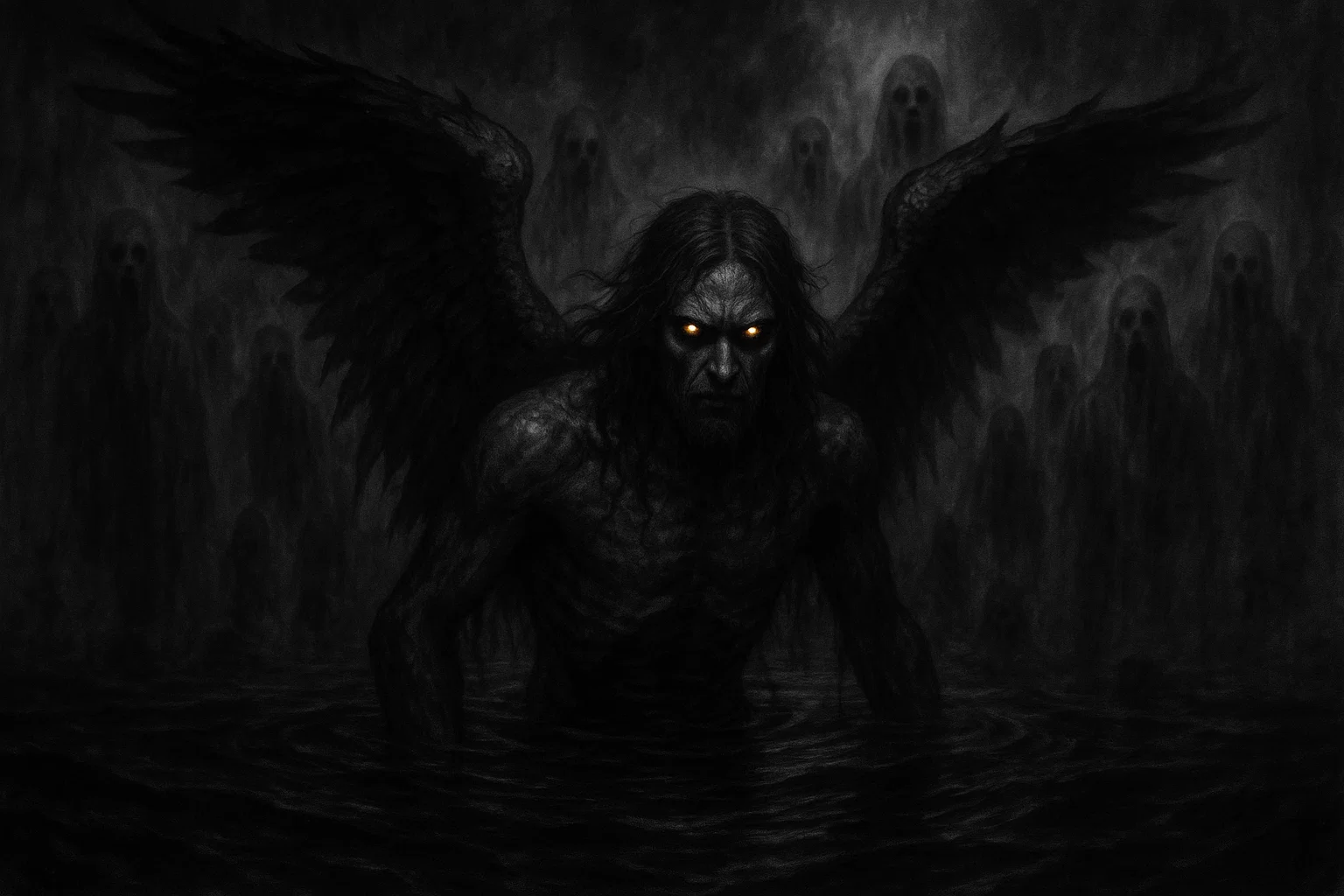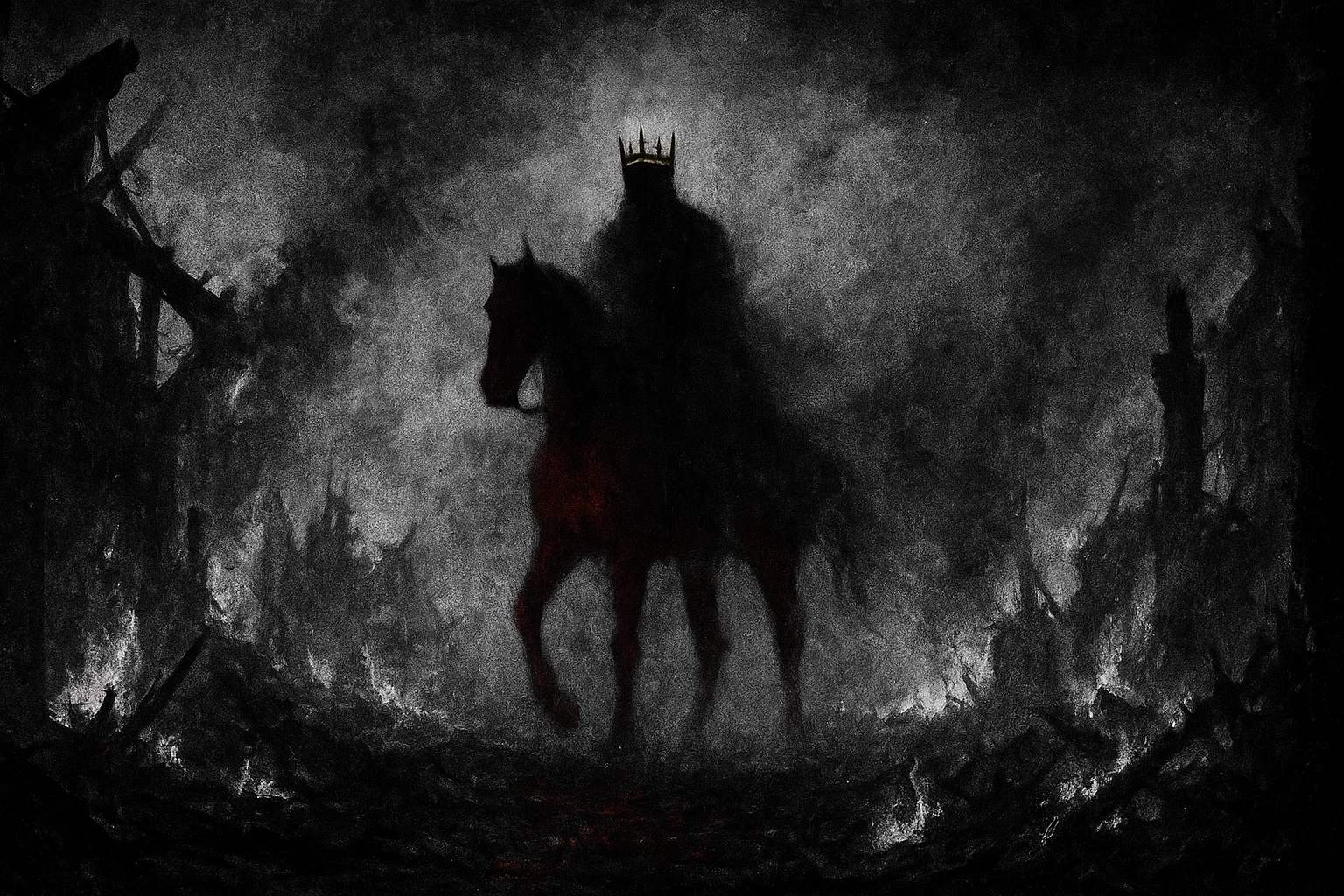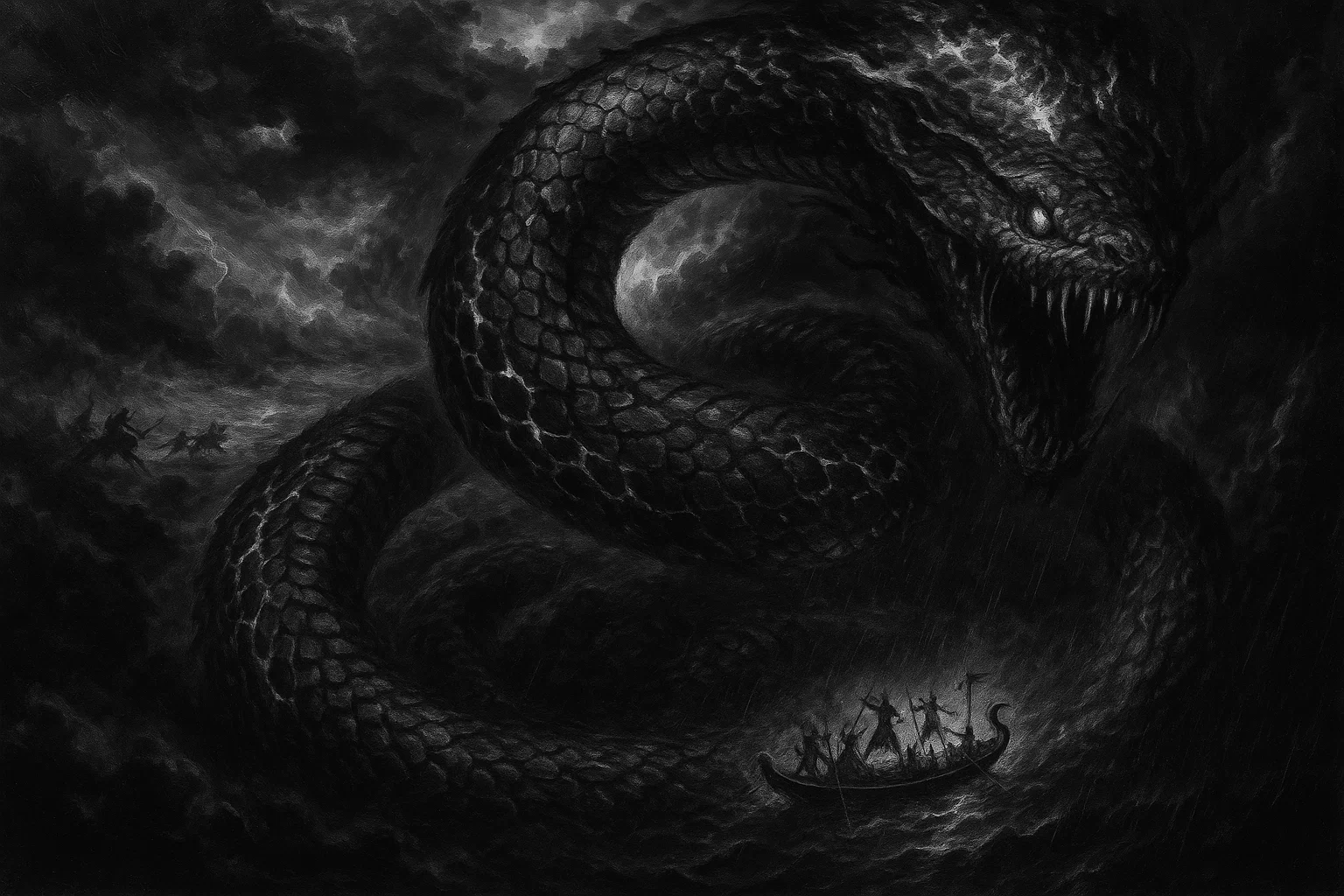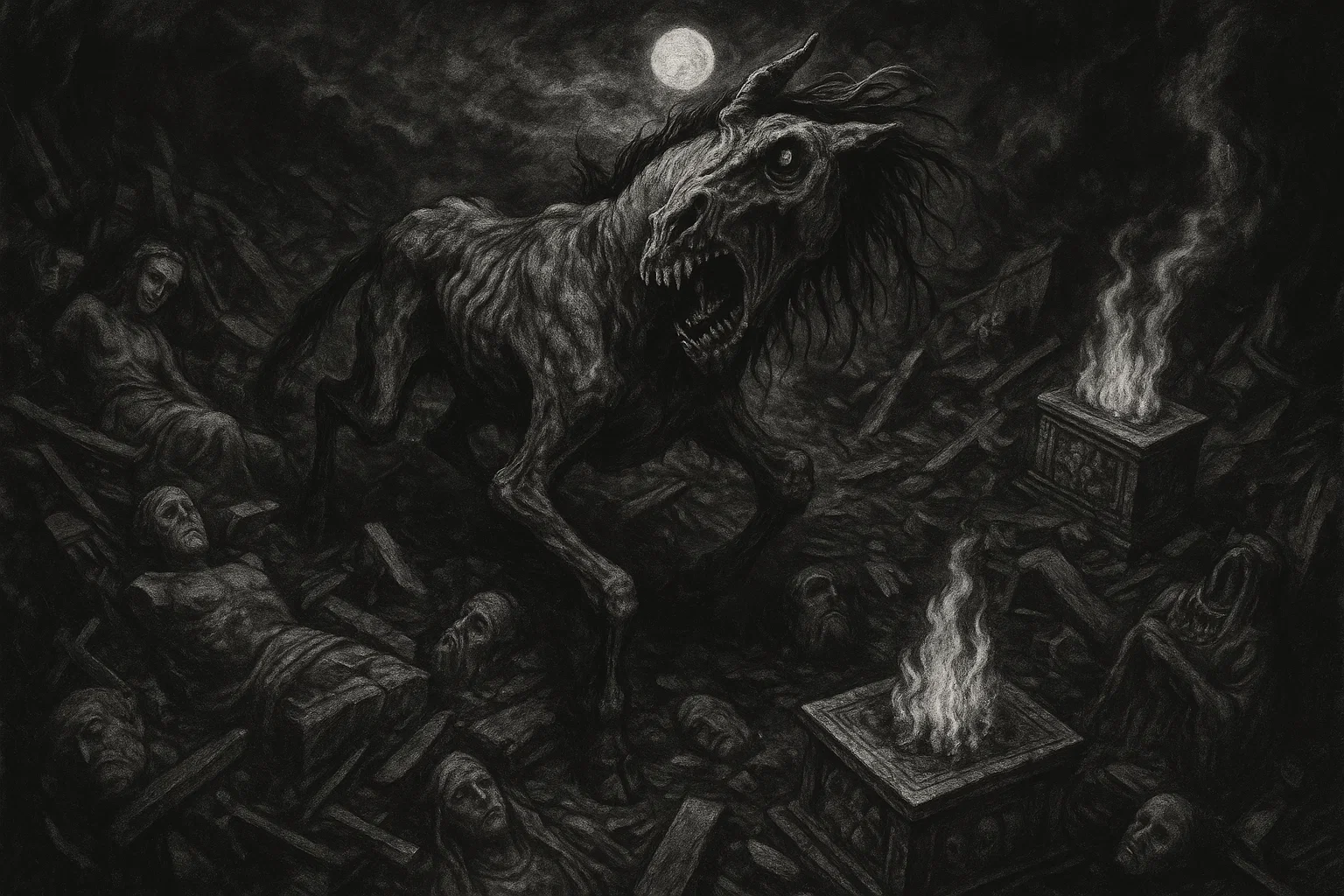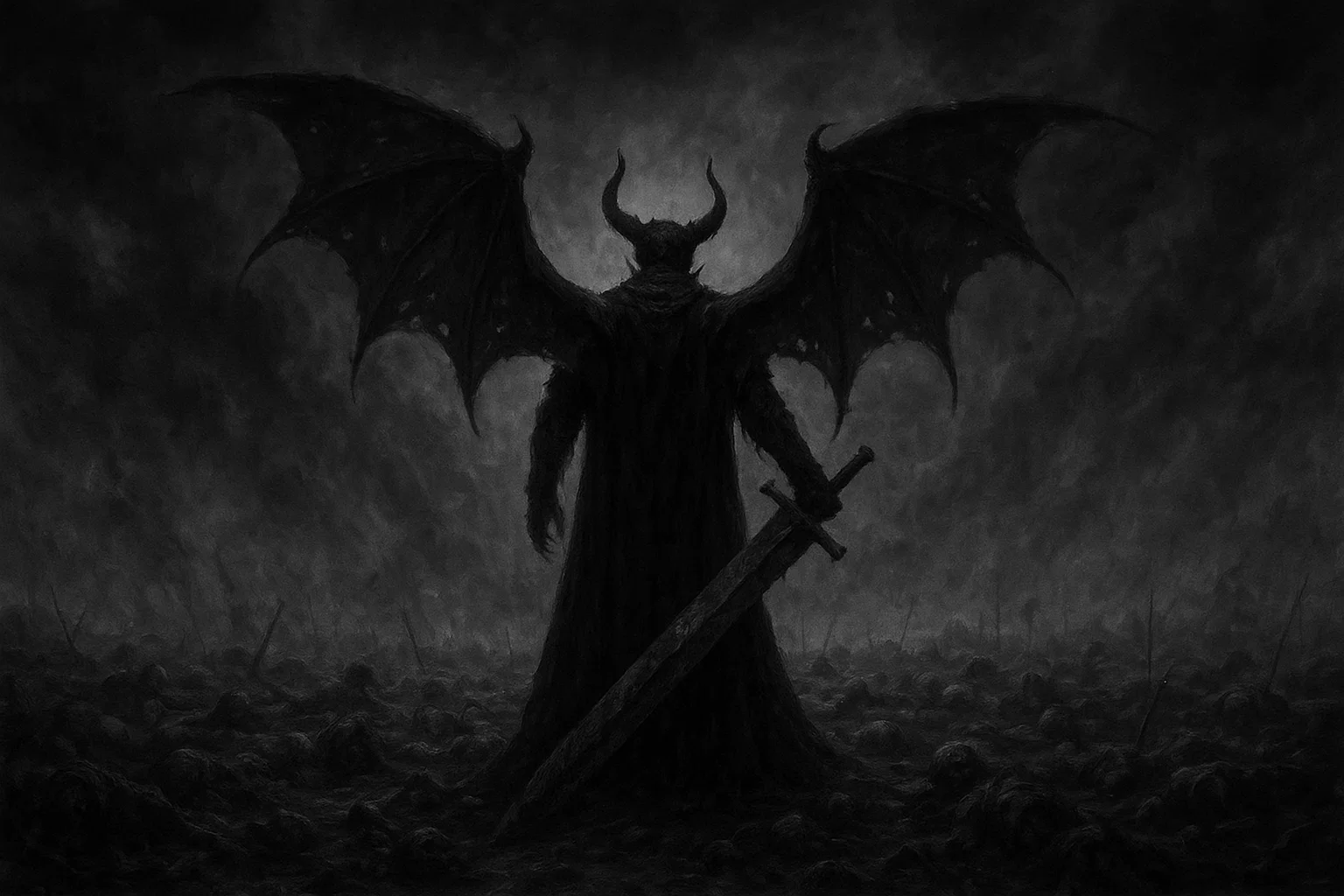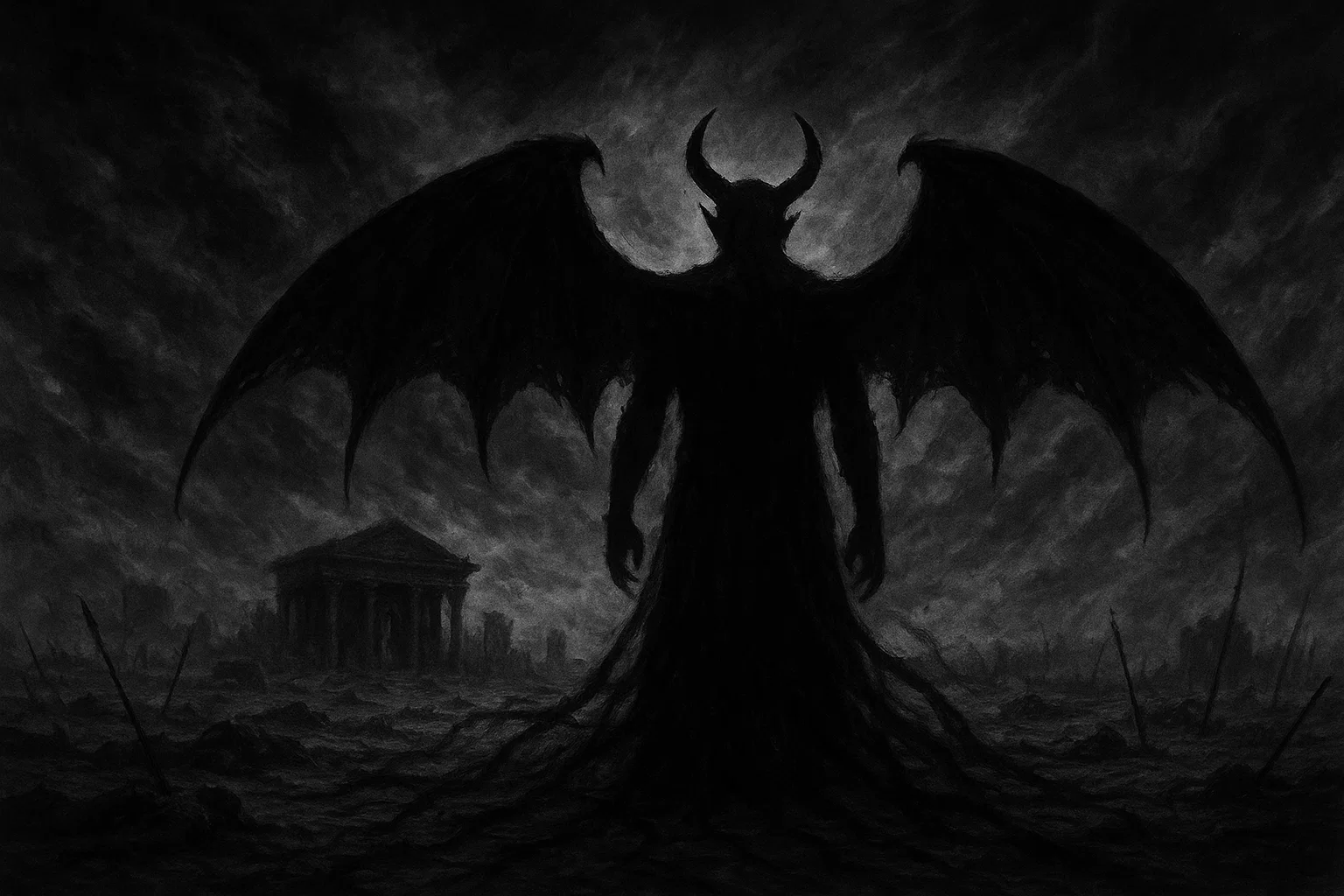In the murky depths of ancient grimoires, where shadows coil around forbidden secrets, lurks Crocell—a fallen duke whose whispers promise untold mysteries but deliver only corruption and despair.
This infernal entity, once a celestial being of the Order of Powers, now embodies the treacherous allure of hidden knowledge, drawing the unwary into webs of deception and ruin. Crocell, the demon whose name reverberates like the ominous rush of unseen waters, tempts mortals with illusions of enlightenment, only to drown them in moral decay and eternal peril.
What forbidden arts does Crocell unveil to those bold enough to summon him? How does his mastery over water’s deceptive calm mask the storms of temptation he unleashes? As a pivotal figure in demonology, Crocell’s legacy spans grimoires and occult traditions, blending remnants of angelic form with the malice of Hell’s hierarchy.
His influence, steeped in the Ars Goetia and similar texts, raises chilling questions: Can one truly harness his teachings without succumbing to his corrupting grasp? Does his enigmatic speech conceal truths or merely sow seeds of madness?
Table of Contents
Key Information
| Attribute | Details |
|---|---|
| Name | Crocell, Crokel, Procell, Procel, Pucel, Crocellatus, Prucel |
| Title | Duke of Hell, Great Duke, Duke Great and Strong, Duke of Water |
| Gender | Male (depicted with masculine traits, though some interpretations note androgynous or fluid elements in modern occult views) |
| Role | Corrupter through false knowledge; manipulator of water illusions; teacher of deceptive sciences and mysticism; instigator of chaos via elemental disturbances |
| Hierarchy | 49th spirit in the Ars Goetia; Duke in the infernal nobility, positioned below kings and princes but above marquises, earls, presidents, and knights |
| Servitors | Commands 48 legions of lesser demons, including unnamed spirits specialized in water manipulation and illusory deceptions |
| Superior Demon | Operates under higher infernal monarchs such as King Asmodeus, Prince Beelzebub, or directional king Amaymon in Goetic structures |
| Powers | Imparts corrupted knowledge in geometry, liberal arts, and occult mysteries; generates illusions of roaring waters; warms and distempers baths to lure victims; reveals hidden thermal sources as traps; speaks in cryptic riddles to confuse and corrupt |
| Appearance | Appears as a dusky angel with expansive wings, dark flowing hair, fiery eyes, and sometimes a mermaid-like lower body symbolizing treacherous waters |
| Etymology | Rooted in Latin “crocellatus,” evoking rattling or rustling sounds akin to water over stones; variations link to “procellosus” for stormy tempests |
| Associated Figures | Linked to fallen angels from the Order of Powers (Potestates); possibly synonymous with Pucel in French demonology; speculative ties to ancient water entities |
| Weaknesses | Repelled by invocations of faith, holy symbols, protective circles, and opposing celestial forces; vulnerable to rituals emphasizing purity and humility |
| Opposing Angel/Saint | Countered by angels such as Semlin; saints including St. John for purification, St. Andrew for resilience, St. Jerome for scholarly protection, St. Francis of Assisi for humility, St. George for combat against evil, St. Vincent for endurance, and St. Clement for water-related safeguards |
| Equipment/Tools | Sigil for evocation; chalices or vessels for water rituals; no prominent weapons, but associated with illusory floods as offensive tools |
| Pantheon | Rooted in Christian demonology, Goetic and Solomonic traditions; influences from medieval occultism, Renaissance grimoires, and broader infernal lore |
Etymology
The name Crocell finds its origins in ancient linguistic roots, primarily Latin, where “crocellatus” signifies a rattling or rustling noise, much like the subtle disturbance of water flowing over pebbles or leaves. This auditory imagery aligns seamlessly with Crocell’s dominion over aquatic elements, portraying him as a demon whose presence is heralded by unsettling, hidden sounds that foreshadow deception and turmoil.
Scholars in occult etymology suggest this term encapsulates the demon’s ability to disrupt calm surfaces, revealing underlying chaos, a metaphor for how he corrupts the human mind with whispers of forbidden knowledge.
Variations such as Procell or Crokel further deepen the etymological layers, potentially deriving from “procellosus,” a Latin word denoting stormy or tempestuous conditions. This connection emphasizes Crocell’s stormy temperament, where his teachings, though appearing enlightening, brew internal storms of doubt and moral erosion.
In some demonological analyses, the name’s phonetic structure—harsh “cr” sounds softened by vowels—mirrors the demon’s dual facade: an angelic appearance concealing infernal malice, a common theme in Goetic nomenclature.
Broader linguistic explorations link Crocell to Indo-European roots related to “krek,” meaning to croak or rattle, evoking frog-like sounds near water bodies, which in folklore symbolize transformation and deceit.
Some modern interpretations speculate ties to ancient Semitic or Hebrew influences, where similar phonemes denote hidden flows or secrets, though these remain speculative. In French demonology, the variant Pucel may stem from “puce,” implying flea-like irritation, symbolizing persistent temptations that itch at the soul.
Occult linguists also draw parallels to “croaker,” an archaic term for ominous prophets, reinforcing Crocell’s role as a cryptic speaker of mysteries. This etymology evolves across grimoires, from early Pseudomonarchia Daemonum entries to later compilations, where name shifts reflect cultural adaptations, underscoring Crocell’s adaptability in corrupting diverse seekers.
Ultimately, the name Crocell serves as a sonic emblem of his watery, deceptive essence, luring the curious into linguistic and spiritual traps.
You May Also Like: Gilles Garnier: Was This French Hermit a Real Werewolf?
What does the Demon Crocell Look Like?
Crocell materializes in a form that deceitfully blends celestial beauty with aquatic menace, often appearing as a tall, ethereal angel shrouded in dusky shadows. His wings, broad and feathered yet tinged with an unnatural darkness, span wide, casting eerie silhouettes that hint at his fallen status.
Key physical traits include long, flowing dark hair that undulates like river currents, piercing eyes glowing with infernal fire, and a complexion that shifts from pale radiance to murky depths. In some manifestations, his lower body morphs into a scaled, mermaid-like tail, emphasizing his command over water’s treacherous allure, complete with subtle fins that ripple ominously.
This hybrid appearance serves to disarm summoners, presenting an illusion of divine guidance before revealing the demon’s corrupting intent through subtle distortions, such as water droplets forming illusory chains around his form.
Historical and Mythological Background
Crocell’s origins trace back to the celestial realms, where he once served as a prince in the angelic Order of Powers, also known as Potestates, guardians of divine order and cosmic balance.
His fall from grace, akin to the broader rebellion led by Lucifer, stemmed from hubris and a thirst for autonomous power, leading to his exile into Hell’s abyssal hierarchy. This descent transformed him from a protector of heavenly secrets into a corrupter of mortal minds, embodying the perversion of knowledge into tools of damnation.
Speculative connections link Crocell to ancient water deities across global mythologies, where water spirits often represent duality—life-giving yet destructive. In Mesopotamian lore, he echoes aspects of Apsu, the primordial freshwater abyss, corrupted into a chaotic force after conflict with younger gods.
Egyptian parallels draw to Nun, the watery chaos from which creation emerged, but in Crocell’s case, twisted into eternal disorder. Greek mythology’s Poseidon, god of seas and earthquakes, shares elemental dominion, though Crocell’s illusions mimic the deceptive calm before Poseidon’s storms, luring sailors to doom.
Norse traditions offer ties to Ran, the sea goddess who drowns the unwary with her net, mirroring Crocell’s watery temptations that ensnare souls. In Hindu epics, Varuna, overseer of cosmic waters and moral order, contrasts Crocell’s perversion, where hidden baths become traps rather than purifying rites.
African Yoruba orishas like Olokun, ruler of ocean depths, reflect mysterious underwater realms, potentially influencing Crocell’s cryptic speech as echoes of oracular divinations gone awry.
Celtic folklore’s undines or water nymphs, seductive yet dangerous, align with Crocell’s mermaid-like depictions, demonized in Christian contexts as fallen entities tempting mortals from purity.
Mayan connections to Chaac, the rain god, highlight stormy aspects, while Aztec Tezcatlipoca’s illusory powers parallel Crocell’s deceptions, suggesting cross-cultural syncretism in demonological evolutions.
The Fall from Celestial Heights
In legendary accounts, Crocell’s expulsion from the Order of Powers occurred during the great angelic war, where his expertise in cosmic geometries—once used to maintain heavenly architectures—became weapons of rebellion.
Cast down, he retained fragments of this knowledge, now corrupted to design infernal labyrinths that trap souls. One myth narrates Crocell attempting to flood Eden’s rivers with illusory waters, aiming to drown humanity’s innocence, only to be thwarted by archangels, cementing his enmity with celestial forces.
This story underscores his role as a tempter of intellect, where fallen angels like him whisper mathematical secrets to alchemists, leading to hubristic experiments that summon greater evils. Interactions with figures like Azazel, another fallen teacher of forbidden arts, portray alliances in disseminating corrupting lore, fostering humanity’s downfall.
You May Also Like: Is The Anguished Man Painting Truly Cursed?
Summonings and Deceptive Revelations
Renaissance occult tales depict Crocell summoned by mages seeking alchemical formulas, only for his cryptic utterances to manifest as flooding visions that overwhelm the mind. In one apocryphal legend, a Venetian scholar evoked Crocell for hidden thermal springs, discovering baths that healed physically but eroded the soul, turning him into a vessel for demonic possession.
Crocell’s interactions with summoners often involve bargains where knowledge exchanges for loyalty, binding the human to infernal pacts.
These narratives warn of his alliances with other Goetic demons, such as Vepar, another water manipulator, combining forces to create illusory seas that drown armies in battles of the occult. Adversarial encounters with saints like St. Clement, who calmed stormy waters, highlight Crocell’s defeats when faith pierces his deceptions.
Watery Temptations in Folklore
Crocell’s lore intertwines with global water myths, where he embodies corrupted river spirits luring travelers to watery graves.
In European folktales, he parallels the Nix, shape-shifting water beings that promise wisdom but deliver death, his angelic form seducing with songs of mystery. Asian connections to Kappa, Japanese water imps teaching forbidden skills, reflect similar temptations, while Polynesian shark gods like Kamohoali’i share predatory aquatic traits.
A specific legend involves Crocell clashing with the Babylonian god Ea, master of wisdom and waters, in a battle over hidden abyssal knowledge, resulting in Crocell’s banishment to infernal depths. These stories illustrate his interactions with deities as adversarial, seeking to pervert their domains into tools of corruption.
Modern Interpretations and Pop Culture Echoes
In contemporary occult narratives, Crocell appears in fictional grimoires as a mentor to dark sorcerers, his powers expanded to include digital illusions mimicking water flows in virtual realms, corrupting through technology.
Pop culture depictions, though sparse, feature him in role-playing games as a boss summoning tidal waves, or in novels where protagonists battle his enigmatic riddles to avert apocalyptic floods.
These adaptations emphasize his role in tempting artists with creative insights that lead to obsessive madness, drawing from historical lore while adding layers of psychological horror.
You May Also Like: What Is a Draugr? The Undead Monster of Norse Mythology
Historical Mentions
| Text/Grimoire | Year | Description | Excerpt |
|---|---|---|---|
| Pseudomonarchia Daemonum | 1577 | A great duke appearing as an angel, speaking darkly of hidden things, teaching geometry and liberal arts, causing water roars, warming waters, and distempering baths; commands 48 legions. | “Procell is a great and a strong duke, appearing in the shape of an angell, but speaketh verie darklie of things hidden, he teacheth geometrie and all the liberall arts, he maketh great noises, and causeth the waters to rore, where are none, he warmeth waters, and distempereth bathes at certeine times, as the exorcist appointeth him, he was of the order of potestats, and hath fourtie eight legions under his power.” |
| The Lesser Key of Solomon (Ars Goetia) | ~1650 | The 49th spirit, a strong duke manifesting as an angel, teaching geometry and sciences, producing water noises, warming waters, discovering baths; rules 48 legions from the Order of Powers. | “The Forty-ninth Spirit is Crocell, or Crokel. He appeareth in the Form of an Angel. He is a Duke Great and Strong, speaking something Mystically of Hidden Things. He teacheth the Art of Geometry and the Liberal Sciences. He, at the Command of the Exorcist, will produce Great Noises like the Rushings of many Waters, although there be none. He warmeth Waters, and discovereth Baths. He was of the Order of Potestates, or Powers, before his fall, as he declared unto the King Solomon. He governeth 48 Legions of Spirits.” |
| Dictionnaire Infernal | 1818 | A duke appearing as an angel, expert in mysticism, teaching geometry and arts, generating tidal noises; commands 48 legions. | “Pucel ou Pocel ou Pricel ou Crocell ou Crokel est un démon issu des croyances de la goétie qui apparaît en 49e position de sa liste de démons sous le nom de Crocell. Ce puissant duc de l’Empire infernal commande 48 légions et enseigne la géométrie ainsi que les arts libéraux. Ce démon produit de grands bruits et réchauffe les eaux.” |
| The Discoverie of Witchcraft | 1584 | A duke teaching arts, warming waters, making noises; commands 48 legions. | “Procell (Crocell) is a Duke and he teaches geometry and all liberal arts. He warms the waters and distempers baths during certain times. Procell commands 48 legions of spirits.” |
Crocell’s Powers and Abilities
Crocell’s arsenal of powers centers on intellectual deception and elemental manipulation, setting him apart from demons relying on overt violence or carnal lures. His core ability to teach geometry and liberal sciences corrupts by presenting knowledge as empowering, yet laced with errors that lead to disastrous applications, such as flawed architectures collapsing under infernal influences or scientific pursuits breeding ethical voids.
Unlike common demonic possessions, Crocell’s teachings foster gradual arrogance, isolating victims from society as they chase elusive mysteries, ultimately eroding their humanity.
Water-related powers amplify his treachery: warming waters offers false comfort, tempting the weary into baths that soothe the body while infiltrating the mind with visions of grandeur, paving the way for pacts of servitude.
Discovering hidden baths serves as bait for explorers, revealing sites that become portals for lesser demons. Producing illusions of rushing waters instills panic or awe, disrupting battles or rituals, a unique trait not shared by most infernal entities.
Speaking mystically of hidden things, Crocell delivers riddles that promise revelation but deliver confusion, tempting scholars with partial truths that drive obsessive quests, often culminating in madness or betrayal of kin.
In modern occult interpretations and pop culture, his powers evolve: in demonolatry practices, he tempers harsh emotions falsely, leading to suppressed rage erupting violently; in fictional media like role-playing games, he summons digital floods or manipulates virtual realities, corrupting through technology’s hidden depths.
Additional abilities in contemporary lore include ego amplification, breeding hatred as astrological influences suggest, or transmuting emotions into creative bursts that consume the artist.
These expansions highlight Crocell’s adaptability, using modern temptations like online mysteries to ensnare digital-age seekers, always with the intent to corrupt and claim souls.
| Power/Ability | Description | Source | How It Tempts/Corrupts Humans | Countermeasure |
|---|---|---|---|---|
| Teaching Geometry and Liberal Sciences | Delivers corrupted insights into mathematics, arts, and occult principles, riddled with deceptive flaws. | Ars Goetia, Pseudomonarchia Daemonum | Lures with intellectual superiority, fostering hubris that alienates and leads to moral compromises. | Prayers to St. Jerome for true wisdom; humility-focused meditations. |
| Warming Waters and Discovering Baths | Heats liquids and locates thermal sources, creating illusory sanctuaries. | Dictionnaire Infernal, The Discoverie of Witchcraft | Provides physical ease as entry to dependency, symbolizing emotional vulnerabilities exploited for pacts. | Holy water blessings or invocations to St. John for elemental purity. |
| Producing Illusions of Rushing Waters | Generates auditory and visual hallucinations of turbulent floods without actual presence. | Ars Goetia | Induces fear or false awe, disrupting sanity and tempting with promises of control over chaos. | Protective circles and appeals to angel Semlin for illusion dispelling. |
| Speaking Mystically of Hidden Things | Communicates enigmatic secrets that obscure more than reveal. | Pseudomonarchia Daemonum | Draws seekers into obsession with riddles, eroding reality and encouraging isolation. | Recitation of Psalms like 26 or the Credo to unveil deceptions. |
| Tempering Harsh Emotions (Modern) | Falsely calms anger or turmoil, building to explosive releases. | Contemporary demonolatry | Offers emotional relief as bait, leading to volatile behaviors and relational destruction. | Rituals invoking St. Francis of Assisi for genuine peace. |
| Amplifying Ego and Hatred | Inflates self-importance, breeding animosity. | Astrological grimoires | Tempts with power illusions, corrupting through division and conflict. | Faith-based humility exercises and saintly intercessions. |
You May Also Like: Complete Guide to Virginia Bigfoot Sightings (1879–2025)
How to Counter Crocell’s Powers
Countering Crocell demands vigilant spiritual defenses tailored to his watery and intellectual deceptions. Begin with fortified protective circles etched in salt or chalk, inscribed with holy names to bar his illusory intrusions, as these disrupt the flow of his elemental energies.
Invoke opposing forces like the angel Semlin, whose clarity pierces cryptic speech, or saints such as St. Jerome for safeguarding scholarly pursuits from corruption. Holy water, consecrated under full moons, neutralizes warmed baths, transforming tempting sanctuaries into repelling barriers.
For auditory illusions, chant Psalms 91 or 26 repeatedly, their rhythms drowning out false roars and restoring mental equilibrium. Against knowledge temptations, practice humility through fasting or confession, countering ego inflation with grounded faith.
In severe summonings, employ exorcism rites emphasizing the Cross or Archangel Michael’s sword, severing infernal ties. Modern countermeasures include digital wards, like blessed screens, to block evolved technological manipulations, always rooted in unwavering devotion to thwart Crocell’s corrupting whispers.
Crocell’s Role in the Hierarchy of Hell
Within Hell’s rigid hierarchy, Crocell occupies the esteemed yet subordinate rank of Duke, commanding 48 legions of demons specialized in deception and elemental chaos. This position places him in the mid-tier nobility, answerable to kings like Asmodeus, who oversees lust and wrath, or Beelzebub, lord of gluttony and lies, directing Crocell’s forces in campaigns of intellectual subversion.
Princes such as Lucifer himself may summon him for strategic counsel, utilizing his mystical insights to plot against heavenly orders.
Crocell rules over infernal domains resembling vast, shadowy aquifers—labyrinthine underground rivers where souls drown in illusions of knowledge, located in Hell’s watery rings akin to the Styx’s tributaries.
His armies, comprising 48 legions (approximately 240,000 spirits if traditional counts hold), include aquatic imps for flood illusions and scholarly fiends spreading false doctrines, unnamed but potent in corrupting academies and explorers.
Notable subordinates might encompass lesser water demons echoing his traits, such as unnamed servitors from Goetic lists, aiding in bath discoveries or riddle dissemination. Superiors extend to directional kings like Amaymon of the East, under whom Crocell operates in evocations, providing tactical support in elemental wars.
Allied demons include Vepar, a fellow duke of seas, collaborating on maritime temptations, or Forneus, teacher of rhetoric, combining forces for eloquent deceptions. Adversaries within Hell comprise fire-based entities like Flauros, whose flames clash with Crocell’s waters in territorial disputes, or higher princes viewing his independence as threats. Celestial foes, like the remaining Powers angels, perpetually oppose him, recalling his fall and fueling eternal rivalries.
This role cements Crocell as a key operative in Hell’s subversive strategies, deploying his legions to infiltrate mortal realms, always advancing the infernal agenda of corruption.
Astrological Associations and Symbolism
Crocell’s astrological profile intertwines with water’s fluid, deceptive nature, symbolizing intuition twisted into manipulation and depths hiding perils.
Primarily linked to Venus, planet of corrupted beauty and hidden desires, he embodies Venusian allure in occult pursuits, where aesthetic knowledge veils malevolent intent. Zodiac associations vary, with Scorpio emphasizing transformative mysteries and watery intensity, or Leo for ego-driven revelations, reflecting his dual angelic-infernal traits.
Elementally, water dominates, representing emotional turbulence and subconscious lures, complemented by earth for grounding illusions in false realities. Numbers like 48 (legions) symbolize abundance turned to excess, while 49 denotes completion of corrupting cycles. Days align with Friday, Venus’s domain, ideal for temptations involving arts or comforts.
Colors include deep blue for oceanic depths, green for Venusian growth perverted into envy, and silver for illusory reflections. Metals such as copper, Venus’s conduit, facilitate rituals, while iron counters his influences in protective talismans. Precious stones like aquamarine enhance water connections, moonstone for mystical deceptions, or emerald for corrupted wisdom.
Planetary hours under Venus amplify his summons, with symbolism extending to symbols like waves or chalices, evoking hidden flows. These associations guide occultists in harnessing—or warding against—Crocell’s energies, always with risks of submersion in his symbolic abyss.
| Association | Details |
|---|---|
| Element | Water (primary), Earth (secondary) |
| Planet | Venus (main), Mercury (for cryptic speech) |
| Zodiac Sign | Scorpio (mystery), Leo (ego), Cancer (emotional waters) |
| Number | 48 (legions), 49 (Goetia position), 7 (transformation) |
| Metal | Copper (Venus), Silver (illusions), Iron (counter) |
| Color | Deep blue (depths), Green (envy/growth), Silver (reflections) |
| Precious Stone/Crystal | Aquamarine (water affinity), Moonstone (mysticism), Emerald (corrupted wisdom), Sapphire (deceptive clarity) |
| Day | Friday (Venus day), Tuesday (for stormy aspects) |
You May Also Like: Who Is Vual in Demonology? Powers, Lore, and Origins
Crocell’s Sigil
Crocell’s sigil, a intricate weave of curving lines and sharp angles resembling flowing rivers intersected by barriers, functions as his infernal signature, essential for summoning rituals that open gateways to his deceptive realm.
Crafted in blue or green inks on consecrated parchment, the sigil channels his watery energies, amplifying evocations when traced during Venusian hours. Its design incorporates symbolic waves and hidden knots, representing entangled secrets and the rustling sounds of his name.
Misuse of the sigil invites unintended floods of illusion, underscoring its power as a tool of corruption. In protective contexts, inverting the sigil wards against his influences, though this demands precise knowledge to avoid backlash.
| Symbol/Item | Association/Meaning | Use in Rituals |
|---|---|---|
| Sigil | Emblem of rustling waters and concealed mysteries; binds Crocell’s presence. | Traced in circles for evocation; burned for banishment. |
| Animal | Fish or mermaids (fluidity, deception); frogs (rattling calls, transformation). | Sacrificial offerings or imagery on altars to invoke elemental ties. |
| Plant | Water lilies (purity perverted); sage (wisdom twisted); reeds (rustling sounds). | Infused in baths or incenses for warming rituals and temptations. |
| Incense | Sandalwood (Venusian mystery); myrrh (hidden depths); frankincense (angelic facade). | Burned to attract Crocell during summons, enhancing cryptic communications. |
| Offering | Chalices of salted water (corrupted purity); thermal minerals (bath discoveries); riddles inscribed on scrolls. | Placed on altars to curry false favor, aiding in deceptive knowledge exchanges. |
| Crystal | Aquamarine (water mastery); obsidian (hidden truths revealed dangerously). | Held during meditations to amplify powers, or shattered for countermeasures. |
Comparison with Other Demons
| Demon | Rank | Powers | Appearance | Legions Commanded | Key Differences from Crocell |
|---|---|---|---|---|---|
| Agares | Duke | Teaches languages, incites earthquakes, destroys dignities. | Elderly man riding crocodile. | 31 | Emphasizes seismic destruction and social upheaval versus Crocell’s watery illusions and intellectual corruption. |
| Valefor | Duke | Induces theft, provides thieving familiars. | Lion with ass’s head. | 10 | Focuses on criminal temptations over scholarly deceptions; lacks elemental affinity. |
| Zepar | Duke | Inflames love, causes infertility in women. | Red-armored soldier. | 26 | Targets romantic and reproductive manipulations, contrasting Crocell’s knowledge-based lures. |
| Botis | Duke | Predicts futures, reconciles foes. | Viper morphing into sword-wielding man. | 60 | Prophetic and diplomatic roles differ from Crocell’s mystical teachings and water controls. |
| Bathin | Duke | Enables instant travel, reveals herbs and stones. | Serpent-tailed man on pale horse. | 30 | Transportation and botanical expertise versus aquatic and geometric corruptions. |
| Sallos | Duke | Sparks love between genders. | Gallant soldier on crocodile. | 30 | Purely amatory influences, lacking Crocell’s scientific or illusory depths. |
| Purson | King | Locates treasures, divines past/future/present. | Lion-faced man on bear with viper. | 22 | Treasure-hunting and omniscient divinations outrank and differ from duke-level water manipulations. |
| Eligos | Duke | Uncovers secrets, foresees wars, garners soldier favors. | Lance-bearing knight on serpent. | 60 | Military prophecies contrast Crocell’s liberal arts and bath discoveries. |
| Vepar | Duke | Guides ships, causes stormy seas, inflicts wounds. | Mermaid. | 29 | Shared water domain but focuses on navigation and injury versus knowledge and illusions. |
| Forneus | Marquis | Teaches rhetoric/languages, fosters friendships/enmities. | Sea monster. | 29 | Linguistic and social manipulations, lower rank than Crocell’s duke status. |
You May Also Like: Buné: Demon King of Riches and Necromancy
Conclusion
Crocell, as a duke of infernal deceit, exemplifies the perils of seeking hidden wisdom from shadowed sources, his powers weaving tapestries of temptation that ensnare the soul. From his fallen angelic origins to his role in Hell’s hierarchy, he serves as a cautionary archetype in demonology, reminding seekers of the costs embedded in occult pursuits.
Exploring Crocell’s etymology, myths, and associations reveals a entity designed for corruption, where water’s flow symbolizes the inexorable pull toward damnation. His legacy endures in grimoires and modern interpretations, a testament to enduring fascination with the forbidden.
In the end, confronting Crocell demands recognition of his malevolent essence—opposite to all that is good—urging vigilance against his whispers, lest one drown in the abyss of his deceptions.

